| |
Author:
Alexander Rokhlin, St. Petersburg
Midrash-picture
resume
|
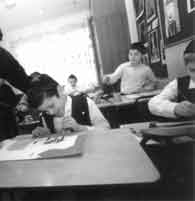
|
This book deals with several tasks from the program of integral teaching art and Jewish classical texts. The program emerged basically from the unique method of teaching discovered in Leningrad underground home-based schools of the early 1980-is. Representatives of many religious trends of the Modernity tried to re-gain the joy of discovery when studying Torah through the interrelation of Torah and tradition on the one hand and culture and art on the other. Our program is based on the child’s ability to “get inside” the Tanakhic text, following the plot in an empathic way. Midrashs and comments by Torah scholars help him in this work. Working this way, the teacher preserves the freedom of his pupil’s self-expression but teaches him from his very first steps in art to analyze his emotions and actions, accustoms him to professional attitude in creating images.
|
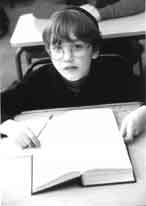
|
In the teaching component the author rests upon the ideas of his teacher Grigory Dlugach, a remarkable Petersburg artist and teacher, the founder of the “Hermitage School”. (One can read about him in: The Hermitage Group of St. Petersburg. Paintings from the Russian Soul. St. Petersburg: Aquilon Co, 1993 (in English). He made his pupils analyze the images in pictures by great masters. At his classes the framework, the constructional basis hidden from the spectator is reduced to a combination of simple geometrical figures. And it is in this basis that the sign, which grows into the visible outlook of the picture, lies hidden.
The teacher should train the young artist to go from greatness of the ideas to simple constituents of mastery. In our work not only the topic itself influences, in an ennobling way, the form of painting, but also the understanding of loftiness of the ideas of the Torah often comes right in the process of painting.
|
A professional teacher of art must be able to explain to a child how images are created. Such art-and-pedagogical directions in teaching art as the “Hermitage School” of Grigory Dlugach enable to teach the methodology of composing pictures, which helps teach pupils to be free, avoiding commonplace and rubber stamps.
Lesson 1.
“Have you penetrated to the sources of the sea?”
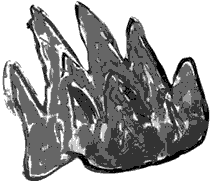
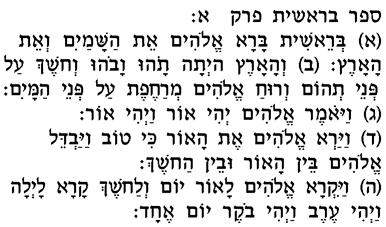
Borya Maximov after 2 years of studying in Sunday school “Lamed” at Petersburg Jewish University started to comprehend new notions and a new image system, which came with studying Jewish tradition. He was thinking about the mysterious words of the Torah “…darkness over the surface of the deep (tehom)”.
Commentators say that tehom is a certain materialization of emptiness — tohu — and differs from the latter by the letter mem, which is a hint to water.
|
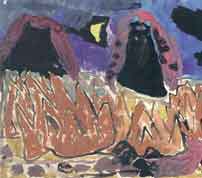
|
Borya’s first composition was in disquieting contrast of blue and orange colors. But pointed rocks were covered with soft and fluctuating forms.
“…and the spirit of God (ruakh Elokim) sweeping (merahefet) over the water…” — in these words our sages see the expression of the mercy of the Most High.
|
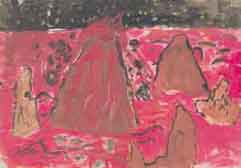
|
In the second picture by Borya orange and yellow flashes, heralds of the incipient light, “reconcile” the red of the rocks with a stripe of the black-and-green tohu.
|
The driving motive of his searches was his desire to reveal in strict forms of yet impersonal world the innermost warmth of mercy intended for the future human being.
Lesson 2. “He made them endure forever establishing an order that shall never change”
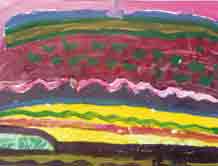
|
In the picture by the 7-years-old Olya Zinger we can see the Earth on the Third day of Creation. The plain text of Torah describing the origin of plants is contradictory in the first and second chapters of the Book Bereshit.
Olya knew the midrash which resolves the contradiction in the Torah text and says that the sprouts, which appeared on the Third day, did not rise till the Sixth day waiting for Man to appear.
We can see rhythmical division of the picture into green and blue horizontal stripes of the saplings alternate with orange-and-red and violet layers of the soil. The color focus is the stripe of pure lemon color. The intensive color spectrum along with the calm frieze composition gives the feeling of expectation ready to explode.
|
|
The picture by Asya Kashtanier shows simultaneously three stages of creation of the Earth’s surface. The upper horizontal line just hints of the original indivisibility of soil and water. The second horizontal line concretizes the texture of the soil. The big rare dabs of dark-blue color tell how unwillingly the water set the soil free, obeying the order of the Almighty. On the lower horizontal line the first verdure in the history of the Earth shines through the spots of dirty soil. The beauty of the clear blue tone of the water gives spirituality to all “materially-minded” color spectrum of the composition, reminding us of the “upper” waters, rakiya, which have remained in heaven, behind the partition.
|
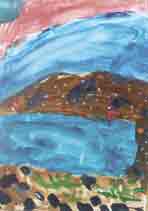
|
Both artists see the moment of creation of the land and seas as bringing order into the world. Horizontal divisions and adjusted rhythm of contrast stripes is the compositional scheme of the majority of children’s works dedicated to the topic of division of land and water.
Lesson 3. “How many are the things You have made, Oh Lord”
On the example of lessons dedicated to the topics of the Fifth and Sixth days of Creation let us regard the ways of working with the Torah text and combination of this work with particular technical painting tasks. For illustration I have chosen two works done in the “pointelle” technique: picture by Vasya Knotenko “Creation of Fishes and Leviathan” and “Creation of animals” by Anya Budovlya.
Retelling a midrash or quoting a commentary, I treat the Torah text, stimulating the child for original organization of the place for development of the plot of the picture.
However, in this case the technique was chosen by the teacher.
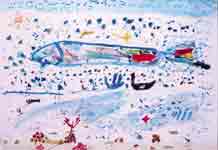
|
In Vasya’s picture in the upper left part of the picture plane there is a huge fish, which moves majestically surrounded by retinue of various sizes. It is one of taninim gdolim, big sea animals, which played the role of the majestic element of the fauna. The fish swimming over corals and ducks has come from another world; it is partially in that world and partially in ours. The author of the picture, moving freely in both worlds, combines both points of view and immerses the spectator into the very depth of things, giving us the feeling of freshness and primeval purity.
|
|
By using the pointelle technique, Anya succeeds in creating the preset image: her animals are monumental but at the same time they have not yet obtained their earthly outlook completely, existing between the worlds. The sages explain that on the Sixth day the animals had to move from the Earth to Gan Eden, where the Almighty showed Adam all the essences or matrixes of the fauna.
In this picture not only the figures, but the background works as well, creating plastic equilibrium between the moving masses and the format of the picture.
|
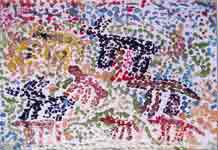
|
Lesson 4. “Man goes out for his labour...”
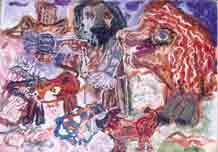
|
Nine-years-old Philip Rokhlin gives another development to the plot of the Sixth day, which arises from the wish to portrait. We see his work “Adam naming the animals”. Clever and keen, the first man understood the predestination of each creature and found a name for it, which corresponded to its nature.
Phillip worked hours over the form. The wish to build a unified construction of the picture shows quantitative change in the level of apprenticeship of the boy. All the personages are elaborated up to the tiniest detail and all are somehow characterized. The man is dressed in very beautiful, skillfully embroidered leather clothes (kotnot or), sewed for him by the Lord Himself.
The artist combined several midrashes, which are different in situations, time and ideas: Adam, the friend of the animals endowing them with names is a colleague of God; Adam, receiving the clothes, kotnot or, is already an exile, apportioned and cast to an alien world. The clothes were graciously presented to the man expelled from Gan Eden.
|
|
The picture by Philip Rokhlin “Og the Giant in Noah’s Ark” is also built on the idea of a portrait. There is a midrash telling that Noah saved Og the giant during the Deluge and the latter promised to serve truly to his descendants. Noah attached a special shelf to the Ark and fed the giant through a hole in the hermetic wall of the Ark.
Another midrash brings together Og and Abraham. Og tells Abraham about Lot’s capture by Babylonian kings in the hope that in the attempt to liberate his nephew Abraham would perish and Og would get Sarah. To compose the outlook of the unsympathetic hero the artist used the origin of the name of Og. According to one of the midrashes, it originates from the word uga — pancake. Trying to warm himself into Abraham’s confidence, Og asked him at great length about how to make matzoth. In the picture by Philip, Og is painted with a curiously dichotomous face: one half is fair, almost white, the other is black — like a badly cooked pancake. The child shows the ‘two-facedness’ of the personage in the literary sense.
The picture built on the idea of rotation of space round the main personage makes one feel the atmosphere of unlimitedly hostile sea, destroying the former life. But even in the life to come Noah’s descendants are to struggle against evil and hypocrisy.
|
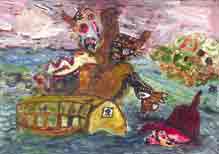
|
Lesson 5. “Truly the eye of the Lord is on those who fear Him…”
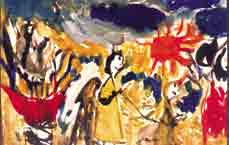
|
In Sunday school “Lamed” there was a very gifted boy Stasik Butovetzky. He painted “Abraham’s sacrifice” when he was 6 years old, after a year of our joint effort.
Let us “read” Stasik’s picture. The image, solved as sign and scheme, nevertheless is rich in associations and full of emotions. The child has managed to inscribe these associations into his sheet. One image flows into another one. The personages undergo deformations, which obey the logics of the artist’s compositional thinking. The color dominant of the picture is the red cup of the altar on the left, the flame in the right corner and the red-hot sun over the child’s figure. In the center of the composition one can see a rope, which ties together the figures of the father, the son, the donkey and the huge tree, surrounded by a piece of ultramarine sky which has broken through the steep slope. Akedath Itzhak is revealed by means of color built on the contrast between the blinding orange and yellow mountain landscape and the dark-blue sky.
|
|
In the town of Beth-Alfa located in the North of Israel an ancient synagogue (VI century) is now being excavated. The mosaic floor of this synagogue was decorated by the scene “Abraham’s sacrifice”. The panel resembles primitive petroglyphs and is equally expressive. The technique of making mosaics from local stones is beyond all criticism. The personages act in a conditional space. Like in Stasik’s picture, the flame of the altar is massive and three-dimensional, there is also a rope, which ties all the personages together into a single whole.
|
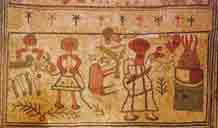
|
Lesson 6. “His splendor covers heaven and earth”
After getting acquainted with Maase Bereshit pupils of one of the forms of school “Beth-Menakhem” got the task to describe the stages of Creation by means of fine art.
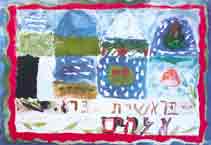
|
In the picture by Misha Smorgonsky all the images are put into squares, which bear the idea of stability. The personages of the Days of Creation are not given in much detail — the scale on which the artist sees the earth is too large. All the twinkling of light and boiling of the form happen beyond their reliable boundaries. The upper row of the images is crowned by an arch, which in this case is the projection of the cupola.
Misha solved the topic of the Seventh Day wisely and tactfully. A beautiful rose connects the Name and the square of Shabbath.
|
|
And here again a child’s work contains astonishing calling-ups with works by masters of the past. “Sarajevo Haggadah” is an illuminated manuscript of the XIV century from Spain, called “Sarajevo” due to the place of its finding. In the illustration in question, the master created otot — signs, formulae of the stages of creation of the World. The first two fragments are for Day One. Over the abyss with storming waves, by vertical flashes of the dark flame, the darkness — khoshekh — is being lit up. It is the stage of tohu-va-vohu — the stage of extreme uncertainty.
The second fragment is much bigger than the others. It depicts the stage of taking the light out. The sages say that in this moment everything was created in the shape of idea, the plot of creation. Actualization begins from separation. Time was created and started to innumerate the stages of seder ishtalshelut — in the language of Kaballah this word means step-by-step concretization of Man and World in the process of Creation.
In the double page of the “Sarajevo Haggadah” the artist gives a plastic hint to this. He encloses the images into arch-shaped stamps. Radial fragments in the upper parts of the stamps are associated with waves or schemes of planetary orbits, allude to the multi-sidedness of what is happening outside the picture. The picture made intuitively by a small child greatly coincides with what was done by a Haggadah artist, a great master and expert in working with the Scripture.
The plots of the Torah, in particular of Maase Bereshit, combines grand descriptions with their concreteness, exciting creative fantasy of artists. Commentaries of the sages require going beyond the limits of plain sense of the text. This makes the artist change the preset inner image. The effort for joint comprehension of the text and the commentaries are combined with the difficulties in realization of the plot in the material. The moving point in the struggle for perception of the sense of Torah and for creation of an adequate artistic form is creative intuition.
The form and the character of depicting give birth to new understanding of the text by the spectator. Moving in the space of the picture, having found himself among color, lines, forms and styles, the spectator perceives the artistic work on the level of emotions. The impressions received make one return to the text of Torah and reveal one’s attitude towards what was read. Thus the midrash is realized through painting, which gives the spectator access to new levels of understanding Torah. The artist becomes the spectator’s guide, while his picture serves as one of the roads, which lead to the world of Torah.
|
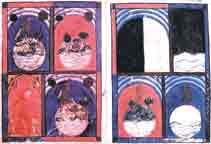
|
The list of the main illustrations
-
«Tohu-va-vohu». Borya Maximov, 9 yo, paper, gouache, 42x29 mm;
-
«The first day of Creation». Borya Maximov, 9 yo, paper, gouache, 42x29 mm;
-
A. Davydova «Spirit over the abyss». Wool, handmade weaving, 2000; -
«Let the ground give rise», Olya Zinger, 7 yo paper, gouache, 42x29 mm;
-
«On the third day of Creation», Asya Kashtanier, 7yo, paper, gouache, 42x29 mm;
-
«Creation of Fishes and Leviatan», Vasya Knotenko, 8 yo, paper, gouache, 42x29 mm;
-
«Creation of animals». Anya Budovlya, 8 yo, paper, gouache, 42x29 mm;
-
«Adam naming the animals». Philipp Rokhlin, 9 yo, paper, gouache, 58x42 mm;
-
«Og the Giant on the Noah’s Arch». Philipp Rokhlin, 9 yo, paper, gouache, 42x29 mm;
-
«Avraam’s sacrifice». Stas Butovetzky, 6 yo, paper, gouache, 27x21 mm;
-
«Avraam’s sacrifice». VI c. Beit-Alpha, Mozaics;
-
«The six days of Creation». Misha Smorgonsky, 9 yo, paper, gouache, 42x29 mm;
-
«Sarayevo Haggadah». Illuminated manuscript. XIV c, Spain.
|
|


